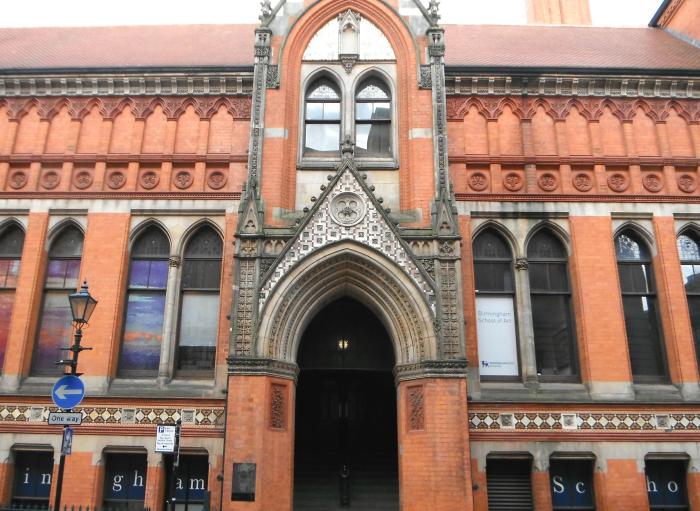In the (admittedly narrow) world of the artistic middle-class – Marga’s milieu – the ‘New Woman’ figure was generally one of respect, and thus there were a number of prominent women achievers who could act as role models to young women.

In the world of stained-glass, women played an especially large part.
In his book ‘Arts and Crafts Stained Glass’ the art-historian Peter Cormack reckons that “Stained glass became the one major Arts & Crafts activity where there was real gender parity in both status and achievement” (p 253). Women were so prominent in the art that a critic of the time, Fred Miller, could even write an article in 1896 called ‘Women Workers in the Arts & Crafts’.
Cormack adds that, by the high point of the 1920s, as many women as men worked in stained glass in London.
Why stained glass making should have been at the centre of such gender parity is not totally clear, though three things spring to mind: the very great influence of Christopher Whall, the doyen of the profession, who insisted on equal opportunity for women both in the workshop and in education; the fact that ‘auteur’ stained-glass making was a relatively clear field at this point; and the work of Mary Lowndes.
Co-education
Christopher Whall’s call for more respect for women in the craft subjects was very influential in the art schools that were then springing up.
Birmingham Art School (in pic), which Margaret attended, was the largest and best-equipped art school in Britain at the time; and encouraged students, including women, to study across the disciplines – from enamelling and metalwork to figure-drawing. One of its leading stained-glass tutors, Henry Payne, had studied with Christopher Whall and imbibed his principles.
Birmingham saw a huge leap in female representation on the staff from 4% to nearly 25% between 1880-1900; and mixed-sex classes – especially for advanced students – were quite the norm by 1900.
It was an unprecedented situation, in which an ambitious woman – one with a strong personality and encouragement – might succeed.
Mary Lowndes
However, without Mary Lowndes it’s doubtful that female independent stained-glass makers could have succeeded as well as they did.
Lowndes was a hugely energetic force. In 1906, she co-founded with Alfred Drury the Glass House studios in south London, where independent artists, including lone women, could work, being supported and encouraged. Within a few months of opening the studios, Lowndes had also formed the Artists Suffrage League, an organisation supporting the Women’s Suffrage Movement.
What effect did the Glass House, a hotbed of progressive social politics, have on a young Margaret setting out on her career? Whatever it was, it was long-lasting, as Marga maintained her association with Lowndes & Drury until the end of her career.
(Read a full account of Mary Lowndes’ life, career and effect on stained-glass at the time by clicking here)
However, it is true to say that when Marga arrived in London, she was not entirely without friends in place. She did have the advantage of having three close relatives around her in London – her aunt (the well-known ceramic sculptor and ‘New Woman’, Ellen Mary Rope), and her cousins Dorothy Anne and Margaret Edith Rope. Like her, these three had also emigrated to live in London (in their case from Suffolk), in order to pursue their art – and all four were singularly unmarried. Each of them worked for their living – family money was thin – and in fact Margaret probably (it’s not quite clear) had to work extra hard, in order to support her mother.
Living in the artists’ quarter of Putney, and in the atmosphere of the times in general, one guesses that the four of them were sympathetic to the progressive opinions of the period.
Women artists
The numbers of independent women stained-glass artists associated with the Glass House – such has Joan Howson, Wilhelmina Geddes & Theodora Salusbury – is impressive, and also included Caroline Townsend, who took a workshop at the studios just a year after Marga, and who was one of the few people whom Marga chose to collaborate with (albeit only once or twice!)
The men and women who were based at the Glass House could, if they had the strength of character, make a living in stained-glass without needing the backing of a glass firm or even formal patrons.
Society
However, while there were totally new vistas for women at this period, one can’t over-estimate the opportunities, even in the Bohemian world of the arts. (See our review article on The Status of Women Artists 1880-1920). Women were still constrained, both in law and in society. Voting rights for women did not even arrive until 1918 – and even then, they were limited.
Pygmalion, the wonderful play written by the socialist George Bernard Shaw, first staged in 1913, expresses well the amazement in male circles that women were beginning to stand up for themselves.
Yes, women could and did make a success of things in this golden period between 1900 and 1925, but they had to be in the right place at the right time – as well as being very tough.
One suspects that Marga may have been among the toughest of them all.
References:
Attribution: many of the facts for this article came from Arts and Crafts Stained Glass (2015, Yale Press) by Peter Cormack
See also: Virgin Mary, as New Woman
**
If you wish to comment on this article, please leave your thoughts in the comments-box below

Birmingham School of Art was funded by the local council and was therefore able to develop a curriculum for the students that helped them develop across a wide range of skills and gave them the opportunity to make the items they designed – eg, in Margas case, The Goblin Market piece in 1905 (?..according to some references 1908)
gary brayne
LikeLike